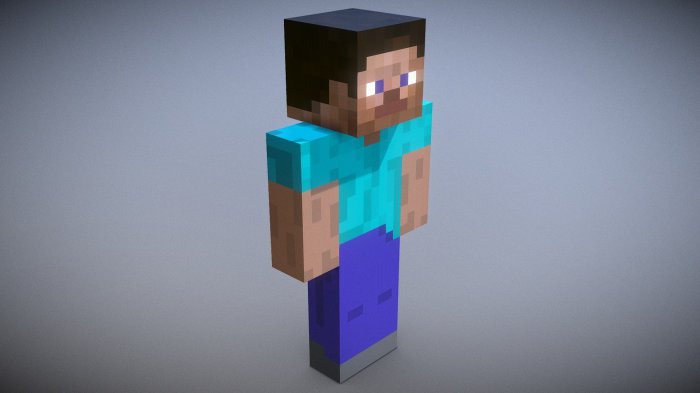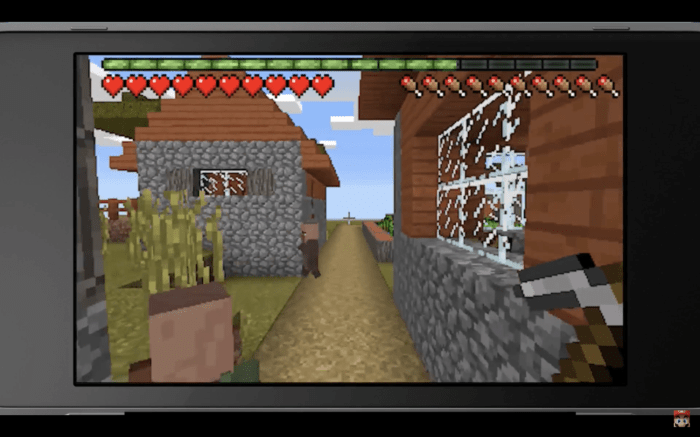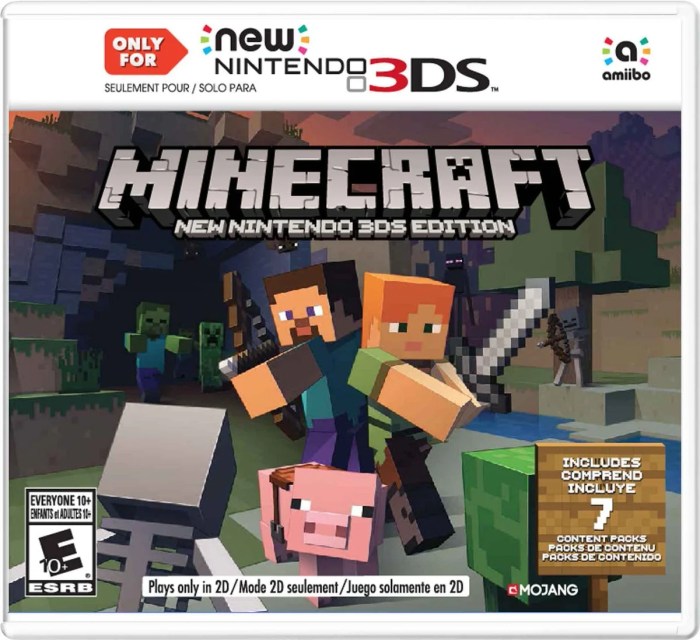Versions of Minecraft 3D take us on a journey through the evolution of this beloved game, from its humble beginnings to its sprawling, blocky landscapes. It’s a story of innovation, creativity, and the enduring power of a game that lets players build anything they can imagine.
We’ll explore the different versions, the 3D environments that define Minecraft, and how the game’s 3D technology has shaped the way we play, learn, and even build in the real world.
From the early days of Minecraft’s development, the focus on 3D environments has been a core element. The game’s unique perspective allows players to experience a sense of depth and immersion, making it feel like you’re actually exploring a vast, open world.
This 3D foundation has been the driving force behind Minecraft’s enduring popularity, attracting players of all ages and backgrounds who want to create, explore, and experience a world unlike any other.
Minecraft Versions: A Timeline
Minecraft has come a long way since its humble beginnings, evolving into a global phenomenon with millions of players worldwide. The game’s development has been marked by significant updates and milestones, each introducing new features, gameplay mechanics, and content that have shaped the Minecraft experience.
Early Alpha and Beta Releases
The first versions of Minecraft, released in 2009, were known as “Alpha” and “Beta.” These early versions laid the foundation for the game’s core mechanics, including block-based building, resource gathering, crafting, and survival. While these early versions lacked many features that define the game today, they introduced the core concepts that made Minecraft unique.
- Alpha 1.0.0 (May 17, 2009):The first publicly released version of Minecraft, featuring basic gameplay mechanics and a limited world.
- Beta 1.0 (December 20, 2010):Introduced new features such as biomes, mobs, and crafting recipes.
Minecraft 1.0: The Official Release, Versions of Minecraft 3D
The official release of Minecraft 1.0 on November 18, 2011, marked a significant milestone in the game’s history. This version included a more polished and complete experience, with a wider range of biomes, mobs, and crafting options.
- Multiplayer: The ability to play with friends online, expanding the social aspect of Minecraft.
- Creative Mode: A new game mode that allows players to build without limitations, providing endless creative possibilities.
Java Edition and Bedrock Edition

Over time, Minecraft has evolved into two primary editions: Java Edition and Bedrock Edition. Java Edition is the original version of Minecraft, developed for Windows, macOS, and Linux, while Bedrock Edition is a cross-platform version that runs on a wider range of devices, including Windows, macOS, Linux, iOS, Android, Xbox, PlayStation, and Nintendo Switch.
- Java Edition:Focused on technical features and mod support, allowing players to customize their experience with mods and plugins.
- Bedrock Edition:Offers a more streamlined experience, optimized for mobile and console platforms.
Major Updates and Milestones
Since the release of Minecraft 1.0, there have been numerous updates that have significantly impacted the game’s gameplay and community. These updates have introduced new features, blocks, mobs, and game mechanics, expanding the possibilities of the game.
- The Nether Update (2010):Introduced the Nether dimension, a dangerous and challenging environment with unique resources and mobs.
- The End Update (2011):Introduced the End dimension, the final destination for players to defeat the Ender Dragon.
- The Aquatic Update (2018):Introduced oceans, coral reefs, new aquatic mobs, and underwater exploration.
- The Caves and Cliffs Update (2021):Overhauled the game’s caves and mountains, introducing new biomes, structures, and mobs.
Exploring 3D Environments in Minecraft

Minecraft’s 3D environments are one of its most defining features, offering a vast and diverse world for players to explore and interact with. These environments are not just visually appealing; they also present unique challenges and opportunities for gameplay.
- Biomes:Minecraft features a wide variety of biomes, each with its own unique characteristics and resources. From lush forests and snowy tundras to scorching deserts and deep oceans, these biomes provide diverse settings for exploration and building.
- Structures:Minecraft’s world is filled with naturally generated structures, such as villages, dungeons, and abandoned mineshafts. These structures offer opportunities for resource gathering, exploration, and adventure.
- Underground Caves:The underground world of Minecraft is just as diverse as the surface, with intricate cave systems, hidden resources, and dangerous creatures. Exploring these caves requires careful planning and resource management.
Building in 3D
Minecraft’s block-based system allows players to build anything they can imagine in three dimensions. The game’s 3D environment offers endless possibilities for creative building, from intricate structures and towering skyscrapers to sprawling landscapes and intricate machines.
- Redstone Mechanics:Redstone is a game mechanic that allows players to create complex circuits and mechanisms, bringing their creations to life.
- Terrain Shaping:Minecraft’s terrain generation allows players to shape the landscape to their liking, creating mountains, valleys, and rivers.
The Importance of 3D in Minecraft Gameplay
The 3D perspective is integral to Minecraft’s gameplay, enhancing the player’s experience and immersion in the game. It allows players to explore the world from multiple angles, interact with objects and environments realistically, and create complex structures with depth and dimension.
- Immersion:The 3D environment creates a sense of immersion, making players feel like they are truly exploring a vast and detailed world.
- Resource Gathering:The 3D perspective allows players to navigate the world and gather resources from different locations and heights.
- Combat:The 3D environment enables players to engage in combat from different angles and positions, adding a strategic element to the game.
Minecraft Modding and 3D Customization
Modding is a popular aspect of Minecraft, allowing players to enhance or modify the game’s features, including its 3D environments. Mods can add new blocks, textures, mobs, and gameplay mechanics, expanding the possibilities of the game.
- Texture Packs:Texture packs modify the visual appearance of the game, adding new textures to blocks, mobs, and other elements.
- Model Packs:Model packs replace the default models of blocks and mobs with custom models, adding a unique visual style to the game.
- World Generation Mods:These mods alter the way the game’s world is generated, creating new biomes, structures, and landscapes.
Minecraft in the Real World: 3D Applications: Versions Of Minecraft 3D

Minecraft’s 3D technology has found applications beyond gaming, extending its reach into fields like education, architecture, and design. The game’s intuitive interface and block-based system make it a valuable tool for creating interactive simulations, prototypes, and learning environments.
- Education:Minecraft is used in classrooms to teach STEM concepts, architectural design, and historical simulations.
- Architecture and Design:Architects and designers use Minecraft to create 3D models of buildings and structures, allowing clients to visualize their projects.
- Prototyping:Engineers and product designers use Minecraft to prototype and test designs in a virtual environment.
Outcome Summary
Versions of Minecraft 3D showcase the evolution of a game that has become a cultural phenomenon. The 3D world of Minecraft has not only captivated gamers but also inspired creators, educators, and even architects to explore new possibilities. Whether you’re a seasoned Minecraft veteran or a curious newcomer, the journey through Minecraft’s 3D environments is a testament to the power of imagination and the magic of building a world block by block.
Q&A
What are the main differences between Java Edition and Bedrock Edition of Minecraft?
Java Edition is the original version of Minecraft, known for its extensive modding community and advanced features. Bedrock Edition is a more streamlined version, available across multiple platforms and optimized for mobile devices.
How do I create custom 3D models and textures for Minecraft?
You can use programs like Blender or Blockbench to create custom 3D models and textures. There are also online tools and resources available to help you get started with modding.
Can I use Minecraft’s 3D technology for real-world projects?
Absolutely! Minecraft’s 3D technology has been used for education, architecture, and even urban planning. It’s a versatile tool that can be used to create interactive simulations and prototypes.